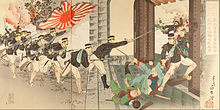Harada Jūkichi
This article needs additional citations for verification. (January 2022) |
Harada Jūkichi | |
|---|---|
| 原田 重吉 | |
 Harada Jūkichi at Pyongyang, by Nawa Nagatoshi. | |
| Personal details | |
| Born | November 23, 1868 Hiaki Village, Mikawa Province, Japan |
| Died | August 6, 1938 (aged 69) Yoshisaka Village, Aichi Prefecture, Japan |
| Military service | |
| Allegiance | Imperial Japanese Army |
| Years of service | 1888–1905 |
| Battles/wars | First Sino-Japanese War Russo-Japanese War |
Harada Jūkichi (原田 重吉, 1868–1938) was a Japanese farmer and soldier who became famous for his actions in the First Sino-Japanese War. Some sources record his given name with the spelling Jūkichi (十吉).
Biography[edit]
Jūkichi was born the second son of Harada Kōkichi (原田 幸吉), a farmer in the village of Hiaki (日明), Mikawa Province. In 1888, he passed the standard conscription examination and was assigned to the 18th Infantry Regiment based in Toyohashi.[1]
In 1894, the Sino-Japanese War broke out, and Jūkichi was called up to participate in the Battle of Pyongyang. On September 15, the order was given to attack Pyongyang in full force, and his regiment approached the heavily fortified Hyeonmu Gate (玄武門).
The Japanese force tasked with assaulting the gate found itself outnumbered and immobilized by Chinese suppression fire. Jūkichi was selected as one of a 13-member forlorn hope charged with climbing the walls. Once inside, Jūkichi and his team were engaged by numerous Chinese warriors. Fending them off, Jūkichi himself opened the Hyeonmu Gate and thereby admitted the Japanese into the city. Pyongyang quickly fell as the Chinese forces within the city routed.[1][2]
Jūkichi's activities became known in Japan through various forms of media including newspapers and popular songs. At the time, he was regarded as a national hero.[3] Jūkichi received a modest promotion to private, first class (上等兵, jotōhei) as well as the Order of the Golden Kite, seventh class.[4]
In 1895, at the end of the war, Jūkichi returned home and soon found himself in debt. In order to pay off his debts, he cooperated with a showman in Nagoya who staged performances of the battle of the Hyeonmu Gate.[5] The play was well received in many places, and there even appeared another show featuring a different person impersonating Jūkichi. After he finished paying off his debts, he quit acting and went back to farming. In 1904, he was called up to fight in the Russo-Japanese War, and returned to Japan in 1905.
Returning to his hometown, Jūkichi devoted the remainder of his life to agriculture. He developed his own fertilizer based on rice hull ash and managed to double the harvest of rice and wheat. For this, he received commendations from the governor of Aichi Prefecture and the prefectural agricultural association in 1923 and 1924.[1] He died in 1938 at the age of 69.
See also[edit]
Further reading[edit]
- Keene, Donald (2005). Emperor of Japan : Meiji and His World, 1852–1912. Columbia University Press. ISBN 0231123418. OCLC 1059567148.
References[edit]
- ^ a b c 豊田市史人物編 Toyota shishi jinbutsuhen (in Japanese). Japan: 豊田市教育委員会 Toyota shi kyōiku iinkai. 1987. p. 508.
- ^ 松平町誌 Hiramatsu chōshi (in Japanese). Japan: 豊田市教育委員会 Toyota shi kyōiku iinkai. 1976. p. 980.
- ^ Soeda, Azenbō. "Azenbō ryūseiki". National Diet Library Digital Collections (in Japanese). 那古野書房 Nagono Shobō. Retrieved 30 January 2022.
- ^ Keene, Donald (2005). Emperor of Japan : Meiji and his world, 1852–1912. Columbia University Press. ISBN 0231123418. OCLC 1059567148.
- ^ "報知新聞 Hōchi Shinbun". January 18, 1932: 7.
{{cite journal}}: Cite journal requires|journal=(help)
